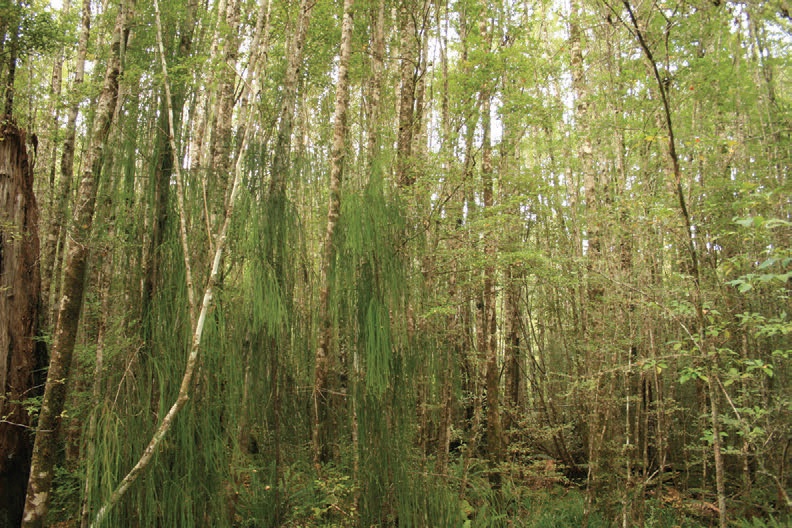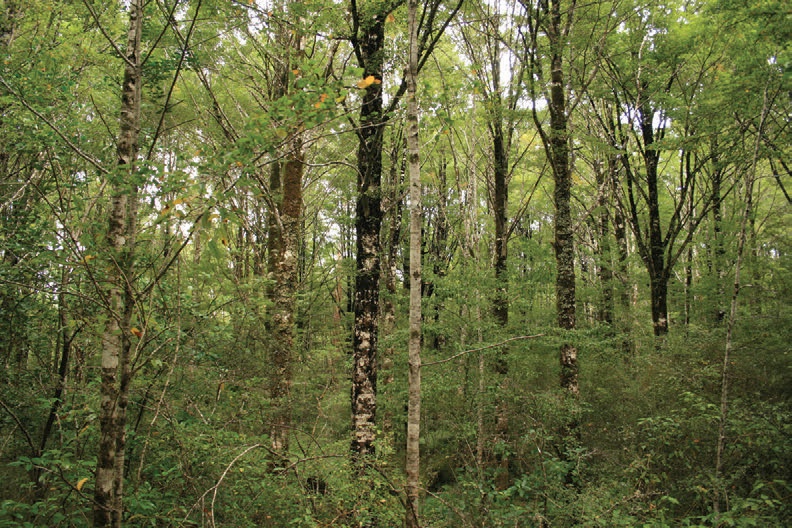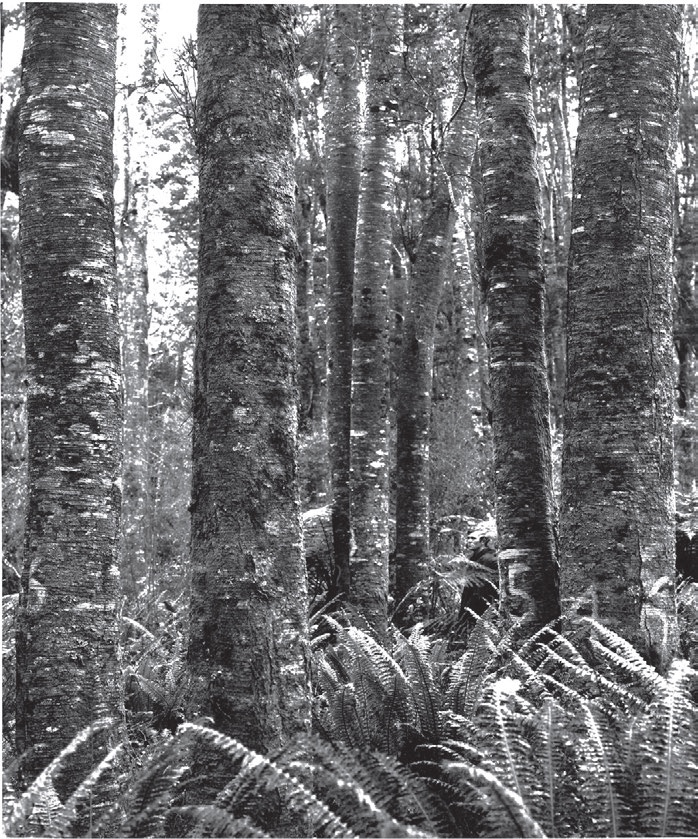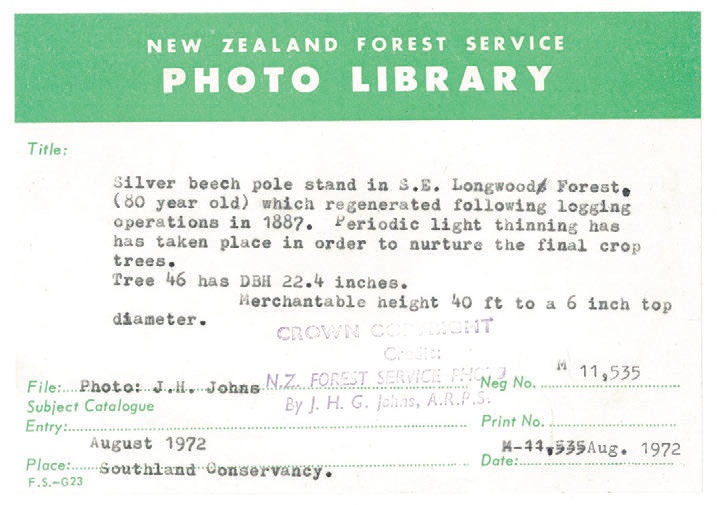Salvaging beech thinning trials – a national heritage
Tomás Easdale, New Zealand Tree Grower February 2012.
An important goal of forestry is to increase tree growth and improve timber yield or its quality on a sustainable basis. Controlling tree density within forest stands by thinning is a simple management opportunity to achieve this goal. Christian Reventlow, a wealthy Danish landowner, in 1811 first challenged the belief that nature knows best and that it is not possible to increase the growth capacity of forests.
Based on personal observations, Reventlow concluded that maintaining an open canopy by frequent thinning of forest stands increased the production of merchantable timber and also total volume production per unit area. Thanks to long- term monitoring excercises using permanent sample plots, we now know that although the second conclusion remains debatable, the first is undisputable.
New Zealand’s largest timber resource is in its extensive beech forests dominated by red, silver, hard, black and mountain beech. However, a major limitation in achieving the income potential from harvesting timber is that beech trees are slow growing in unmanaged stands.They often develop into dense thickets of saplings and pole-sized trees where competition between trees is strong and individual growth rates slow − in the order of two millimetres in stem diameter per year. Thinning provides an attractive alternative to improve timber yield in these young beech stands.
Both the photographs on the right were taken with equal magnification and angle of view on contiguous even-aged 58-year-old mixed red and hard beech stands. One of the stands, the top image, was left unthinned at around 10,000 stems a hectare whereas the other was thinned to 250 stems a hectare
Why do we need thinning trials?


The effects of stand thinning for timber production are generally well established. Stand production is maintained within a wide range of tree densities and thinning can be thought of as a long-term anticipation of natural tree mortality. Thinning will redistribute the increment from smaller to larger stems.
Despite this general understanding, it is difficult to anticipate the magnitude of growth responses to thinning for a range of species and locations and to identify the intensity, timing and frequency of interventions that lead to maximum output. For this reason, during the 1930s, 1950s, and 1970s, the New Zealand Forest Service established many long-term thinning and pruning trials mainly in red, silver, and hard beech forest in Southland and Westland.
These trials consisted of varying stand ages and intensities of thinning. The establishment and maintenance of these silvicultural trials required significant investments and devotion by many people. While some of these trials were periodically reassessed, few had the results analysed and made widely available. Restructuring of government agencies, changing roles of corporations, and the retirement of forestry professionals have put these long-established trials and their records in jeopardy of being lost. This is just when the trees are reaching harvest size and when the true value of these trials is being realised.
Our plan
With support from the NZFFA and the Maori Trustee as well as funding from MAFs’ Sustainable Farming Fund, Landcare Research has started a project to retrieve beech thinning data and related documentation. This is currently scattered in various storerooms and filing cabinets and which require urgent archiving for possible use.


Our project will involve various phases. First we will interview people who were involved with these trials. This exercise is expected to clarify the nature and structure of the documentation and experimental designs and will help identify trials to document and re-locate.
Then we will then produce a database. This will describe various features of each trial such as identifying codes, location and tree species, various details of experimental design including number, timing and intensity of thinning interventions, and details of plot monitoring.
Thirdly, where useful, we will visit trial sites, check current condition and record geographical coordinates. Finally, trials will be ranked according to a number of criteria such as completeness of records, number of measurements, species and location. The best data will be entered and lodged electronically within the National Vegetation Survey Databank to make them readily available for subsequent use. The remaining files will be archived as hard copies.
Encouraging results
Valuable information can be obtained from these trials. Recent remeasurements involving Larry Burrows, David Henley, Gordon Baker and Kev Drew and analyses of two trials established in regenerating beech forest in the early 1970s have demonstrated their potential. We assessed the growth response of silver beech stands thinned from 3,000 to 150 trees a hectare, and of mixed red and hard beech stands thinned from 540 to 150 trees a hectare.
The results of intense thinning are remarkable. Mean stem diameter in 58-year-old stands with 150 trees a hectare is almost double that of unthinned stands − 43.2 cm compared to 21.1 cm for red/hard beech, and 35.9 cm compared to 17.3 cm for silver beech. The somewhat faster diameter growth of red/hard beech, and their taller stems, meant that at 58 years, merchantable sawntimber volumes were up to 21 times higher in thinned mixed red/hard beech stands at 191 cubic metres a hectare.
However sawn timber volumes were just seven times higher in thinned silver beech stands at 127 cubic metres a hectare when compared with unthinned stands. At 58 years, yield tended to maximise at around 190 trees a hectare for red/hard beech stands, whereas it peaked arround 600 trees a hectare for the more shade tolerant silver beech.
We anticipate this project will result in further re- measurement of trials, data analysis, quantification of the gains in tree growth and timber yield that result from thinning and pruning in a wide range of beech species, stand ages and sites. This will in turn result in practical silvicultural prescriptions that can be used to sustainably manage beech forests for quality timber.
Readers of Tree Grower who can provide information related to these historical beech thinning trials are encouraged to contact Larry Burrows or Tomás Easdale at Landcare Research.
Tomás Easdale is a forest ecologist with Landcare Research, Lincoln

 Farm Forestry New Zealand
Farm Forestry New Zealand